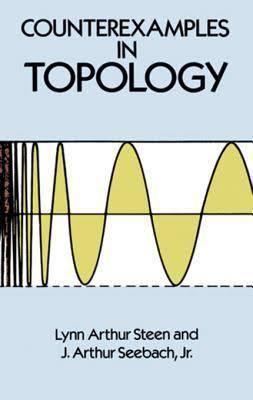8.4 /10 1 Votes8.4
4.2/5 Goodreads Language English Publication date 1970 Pages 244 pp. Editor Lynn Steen | 4.2/5 AbeBooks Country United States Subject Topological spaces Originally published 1970 Genre Non-fiction OCLC 32311847 | |||||||||||||||||||||||||||||||||
 | ||||||||||||||||||||||||||||||||||
Publisher Springer Science+Business Media Similar Topology books, Non-fiction books | ||||||||||||||||||||||||||||||||||
Counterexamples in Topology (1970, 2nd ed. 1978) is a book on mathematics by topologists Lynn Steen and J. Arthur Seebach, Jr.
Contents
In the process of working on problems like the metrization problem, topologists (including Steen and Seebach) have defined a wide variety of topological properties. It is often useful in the study and understanding of abstracts such as topological spaces to determine that one property does not follow from another. One of the easiest ways of doing this is to find a counterexample which exhibits one property but not the other. In Counterexamples in Topology, Steen and Seebach, together with five students in an undergraduate research project at St. Olaf College, Minnesota in the summer of 1967, canvassed the field of topology for such counterexamples and compiled them in an attempt to simplify the literature.
For instance, an example of a first-countable space which is not second-countable is counterexample #3, the discrete topology on an uncountable set. This particular counterexample shows that second-countability does not follow from first-countability.
Several other "Counterexamples in ..." books and papers have followed, with similar motivations.
Reviews
In her review of the first edition, Mary Ellen Rudin wrote:
In other mathematical fields one restricts one's problem by requiring that the space be Hausdorff or paracompact or metric, and usually one doesn't really care which, so long as the restriction is strong enough to avoid this dense forest of counterexamples. A usable map of the forest is a fine thing...In his submission to Mathematical Reviews C. Wayne Patty wrote:
...the book is extremely useful, and the general topology student will no doubt find it very valuable. In addition it is very well written.When the second edition appeared in 1978 its review in Advances in Mathematics treated topology as territory to be explored:
Lebesgue once said that every mathematician should be something of a naturalist. This book, the updated journal of a continuing expedition to the never-never land of general topology, should appeal to the latent naturalist in every mathematician.Notation
Several of the naming conventions in this book differ from more accepted modern conventions, particularly with respect to the separation axioms. The authors use the terms T3, T4, and T5 to refer to regular, normal, and completely normal. They also refer to completely Hausdorff as Urysohn. This was a result of the different historical development of metrization theory and general topology; see History of the separation axioms for more.
